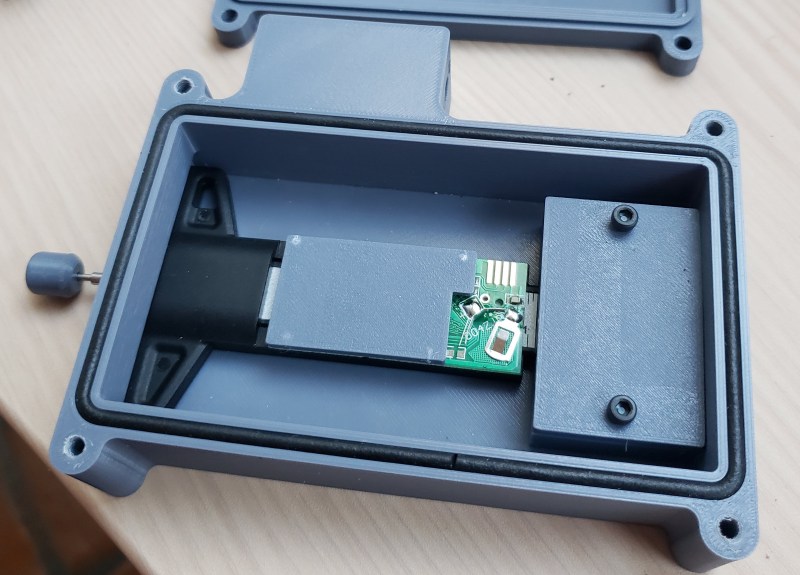There are various ways to measure plant health, and we’ve seen many projects creating open-source solutions. One we haven’t seen is a dendrometer, which involves measuring various physical dimensions of trees to track their health and growth. [John Opsahl] is changing this with the OpenDendrometer, a tool for tracking the diameter of tree limbs and fruit.
Tiny changes in diameter take place throughout the day, and tracking these changes allows deviations to be detected, which can be a sign of water stress. Over weeks and months, these measurements can be used to measure growth and fruits’ progress to harvest. [John] found that a digital tire tread depth gauge can work well for this application. Many of these gauges use the same electronics as the cheap digital calipers, for which the serial protocol was reverse engineered more than a decade ago. The OpenDendrometer connects the tire depth gauge to a microcontroller via a 1.5V level shifter, which logs measurements to an SD card while using a DS3231 RTC for accurate timestamps. The RTC can also be used to wake up the circuit at the required intervals to save battery power. For the initial proof of concept [John] is using an Arduino Pro Mini, but plans to move to an ESP32 at a later stage to allow wireless data transmission.
Everything will be housed in a 3D printed enclosure with a foam cord gasket to make the device weather resistant. A mounting rod on the outside of the enclosure with adjustable thumbscrews allows the OpenDendrometer to be attached to any part of the tree. We plan to keep an eye on this project and look forward to seeing the data it produces.
For the other ways of measuring plant health, we’ve covered everything from soil moisture to Normalized Difference Vegetation Index and even plant weight and even pot plant weight.















No tree hugers on HaD? This is a tree huger and that what what it’s about, it measures the tree’s happiness .
Could be used in Kinsey Institute type studies too.
I’m looking forward to seeing the data (and how to interpret it) on this project too. I didn’t know this was a way to measure tree health. I’m curious about using a screw to attach the device to the tree though, wouldn’t it be better to use a cable tie or some elastic? I was always told screws and bolts provide a route for bacteria, fungi and viruses to get in and damage the tree. How do professionals do it?
They do it using screws: https://www.wsl.ch/en/about-wsl/instrumented-field-sites-and-laboratories/lwf-demonstration-site/20-vegetation-and-biodiversity/28-point-dendrometer.html
You have to be careful and sterilize the screws though. It is still a risk and I don’t think anybody would recommend it on a tree of historical or patrimonial importance.
You can also use band dendrometers but those are less sensitive to small variations in tree diameter (related to trunk water content throughout the day) and are used more to follow trunk growth.
trees like many living organisms have a primitive immune system and they are pretty good at killing everything off on their own. cable ties and elastics are … well to elastic meaning all the data will be extremely noisy since change in temperature and diminishing material strength over time will introduce lots of variables.
very interesting! i am curious to see what data comes from this.
Though, i have one concern: could it be that meter is relying on starting in a default position to calibrate the readout offset? those high resolution readout ICs and sensors tend to have drift.
Finally, IoT for the orchard. I had no idea this was something you could measure, add me to the list of folks waiting for the charts and interpretation.
But, how do the trees feel about having this attached to them?
They will be upset. Many metals are poisonous to plants, a copper plated nail might even kill a tree.
I’m not sure if this device can deliver useful data. The “reference” nail will move as the tree stem expands or contracts, so this construction more or less measures the thickness of the bark. I’d rather measure the circumference indirectly: tie a spring with known mechanical/thermal properties around the stem and have it pull on a load cell.
both are valid methods. they are called band dendrometer and point dendrometer respectively. most of the commercial instruments are still analog in nature and use spring loaded linear potentiometer to measure the relative change in size as change in resistance.
I am curious about viable inexpensive production
I notice the BOM for ESP and RTC add up to $10
Assuming you wanted to use EG Pico W with internal RTC and put the SD reader socket on the custom PCB may be cheaper. Of course everything is cheaper in bulk obvs.
Curious about level shifter, probably not needed on a Pico?
Amazing, looking forward to the results you get!
Maybe this project is interesting for you:
https://treewatch.net/#